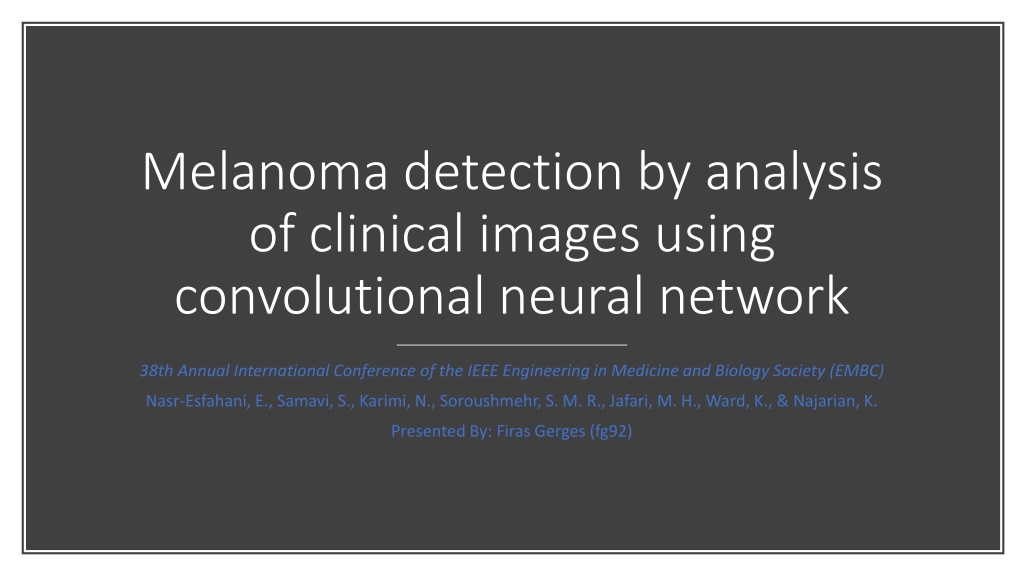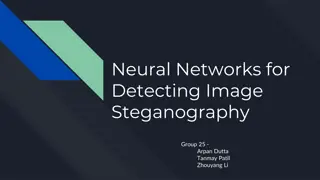Automated Melanoma Detection Using Convolutional Neural Network
Melanoma, a type of skin cancer, can be life-threatening if not diagnosed early. This study presented at the IEEE EMBC conference focuses on using a convolutional neural network for automated detection of melanoma lesions in clinical images. The importance of early detection is highlighted, as experienced dermatologists face challenges in distinguishing between benign and cancerous moles. Computer-based algorithms are being developed to aid in this process, aiming to improve accuracy and efficiency. By analyzing characteristics such as size, pigmentation, asymmetry, border irregularity, and more, the aim is to improve the detection of melanoma through deep learning techniques. Previous studies have utilized image analysis techniques and machine learning to classify cancerous moles based on extracted features. The development of efficient detection software is crucial for early-stage melanoma diagnosis and prevention.
Download Presentation

Please find below an Image/Link to download the presentation.
The content on the website is provided AS IS for your information and personal use only. It may not be sold, licensed, or shared on other websites without obtaining consent from the author. Download presentation by click this link. If you encounter any issues during the download, it is possible that the publisher has removed the file from their server.
E N D
Presentation Transcript
Melanoma detection by analysis of clinical images using convolutional neural network 38th Annual International Conference of the IEEE Engineering in Medicine and Biology Society (EMBC) Nasr-Esfahani, E., Samavi, S., Karimi, N., Soroushmehr, S. M. R., Jafari, M. H., Ward, K., & Najarian, K. Presented By: Firas Gerges (fg92)
Introduction Aim Previous Studies Outline Methodology Experiments and Results Conclusion
Melanoma, known as malignant melanoma, is type of skin cancer Melanoma Caused by abnormal multiplication of pigment producing cells that give color to the skin
Detection Importance Melanoma is a severe disease increasing at a high rate It is regarded as one of the most dangerous skin-cancer type Melanoma can be prevented and cured if diagnosed at an early stage, hence the benefit of having an efficient detection software for early-stage melanoma
Experienced dermatologists are having a hard time ensuring whether a mole on the skin is benign or cancerous Melanoma Detection Automated, computer based algorithms are being developed for this matter.
Aim The aim of this study is to detect the existence of melanoma lesions using deep learning
Methods in Dermatology ABCD Rules: 7 points checklist: Rule out the existence of Melanoma based on certain characteristics of the mole. Change in size of lesion Irregular pigmentation Asymmetry, Border Irregularity, Color Pattern and Diameter Irregular border Inflammation Itch or altered sensation Larger than other lesions (diameter >7mm) Oozing/crusting of lesion
Computer-Aided Methods Previous studies used image analysis techniques to produce the ABCD features. Use ML technique to classify a cancerous mole based on the extracted features
Computer Vision Deep learning has been used widely in different domains: Natural Language Processing Deep Learning Based Methods Speech Recognition Etc. In this paper, the goal is to use deep learning for automated detection of skin cancer using digital images as input.
Image Acquisition http://www.cs.rug.nl/~imaging/databases/melanoma_naevi/ http://www.cs.rug.nl/~imaging/databases/melanoma_na evi/ http://www.cs.rug.nl/~imaging/databases/melanoma_naevi/ Methodology Image preprocessing for noise and illumination effects reduction Running Convolutional NN for classification
The main goal of this step is to reduce the artifacts that may lead CNN to false classification Pre- Processing Images taken by digital cameras, generally include noises and lighting effects that should be eliminated before processing the image
Pre-Processing Three main stages of image handling exists: Illumination Correction Segmentation Filtering
Pre-Processing: Illumination Correction Illumination effects are detected as sharp changes in HSV color space in terms of saturation and value channels Some range of gradients (changes in colors and saturation) are excluded from the image to disregard the lightning effects.
Each image contains normal part of the skin along with the mole Normal skin must not affect the model performance and accuracy Pre- Processing: Segmentation For this, a segmentation process took place in order to generate the image mask, in which the lesion location is shown The importance of keeping the normal skin part is for Color Changing effects
Pre-Processing: Filtering In this step, a Gaussian filter is applied on the normal regions of the skin This is done to smooth the area outside the lesion, hence reducing this area effect on the classification
CNN, as deep learning framework is used for melanoma detection CNN uses convolve filters that examine images various structure CNN The difference between CNN and other techniques that the image itself is the input of the model
CNN Architecture The network consists of a set of layers A layer can be: Convolve Layer Pooling Layer Last layer: fully connected layer
CNN Architecture Conv. Layers uses a set of kernels to filter the input image Each Conv. layer is followed by a pooling layer The pooling layer reduces the size of the constructed feature map This happens to recognize general patterns in the images. These general patterns are observable in resized image.
Conv1: 5 x 5 Kernels 20 feature maps Conv2: 5 x 5 Kernels 50 feature maps Two Convolve layers: CNN Implementation Two Max Pooling layers: Max Pool 1: 4 x 4 Kernels Max Pool 2: 6 x 6 Kernels
Output Layer, i.e. the last layer consists of a 2-layer fully connected stage respectively having 100 and 2 neurons. Output Layer This 2-layer network forms the final diagnosis results
CNN needs a lot of training power in order to result in highly accurate predictive model Training CNN: Number of Sample issue Existing dataset consists of a low number of labeled images due to the fact that it is difficult to collect and label images This problem is fixed by expending the sample
Cropping 5% and 10% from the corner (example, top- left corner: 5% from the top and 5% from the left) Expending the data set is done by collecting a number of images from the same image Scaling the new image to the original size Expanding the dataset Rotating Images by 0, 90, 180 and 270 degrees This is done by: Resizing the images to 188 x 188 pixels This results in a 36 images from each sample
Dataset of skin lesion images is used. http://www.cs.rug.nl/~imaging/databases/melanoma_naevi/ This dataset is publicly available on http://www.cs.rug.nl/~imaging/databases/melanoma_naevi/ Dataset It contains 170 non - dermoscopic images: 70 melanoma 100 non-cancerous After expending the original dataset, the expanded one consists of 6120 images
Data is split into 80% for training and 20% for testing Training set is fed to the network with batches Experiment Each batch size was 64, and the network was trained through 20000 iterations This is repeated 50 times to ensure stability, and the mean value of the results is reported
Performance Metrics
Results were benchmarked against three previous studies done on the same data: (Zagrouba & Barhoumi, 2004) [24] is one of the first reported work, and used as baseline (Munteanu & Coocleam, 2009) [13] is an example of used commercial tools (Giotis et al, 2015) [12] classify cases in a semi-supervised framework Comparing results
the used method in this paper (CNN) outperformed other state-of-the-art methods in terms of classification accuracy Deep Learned based system is able to efficiently detect melanoma cases from non-cancerous ones Discussion and Conclusion Pre-processing of the images led to an increase of CNN accuracy
The difference between CNN and previous studies, is that extracting feature is done automatically within the model, and no explicit feature extraction steps took place Discussion and Conclusion Experimental results that CNN has high predictive accuracy in respect with other detection algorithms.
Nasr-Esfahani, E., Samavi, S., Karimi, N., Soroushmehr, S. M. R., Jafari, M. H., Ward, K., & Najarian, K. (2016, August). Melanoma detection by analysis of clinical images using convolutional neural network. In 2016 38th Annual International Conference of the IEEE Engineering in Medicine and Biology Society (EMBC) (pp. 1373-1376). IEEE. E. Zagrouba and W. Barhoumi, A preliminary approach for the automated recognition of malignant melanoma, Image Analysis & Stereology, vol. 23, no. 2, pp. 121-135, 2004. Reference C. Munteanu and S. Cooclea, Spotmole melanoma control system, 2009. Available: http://www.spotmole.com/ I. Giotis, N. Molders, S. Land, M. Biehl, M. F. Jonkman and N. Petkov, MED- NODE: A computer-assisted melanoma diagnosis system using non- dermoscopic images, Expert Systems with Applications, Elsevier, vol. 42, no. 19, pp. 6578-6585, 2015.























